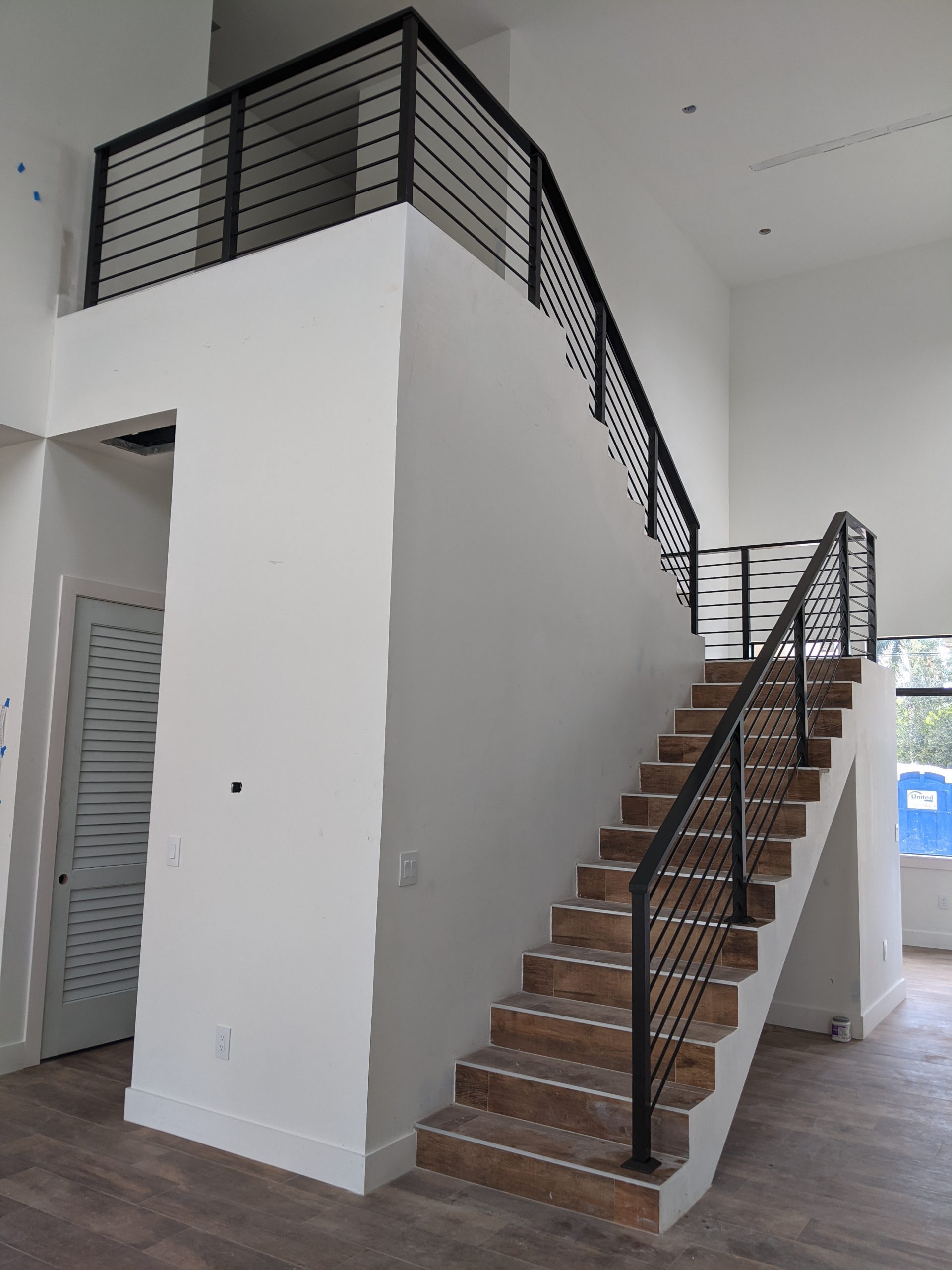
Step 6 – Cut Balusters for the Sloped Section

These pieces will be used for the horizontal section of the stair rails. Take 1×2 poplar wood boards and cut 39 baluster pieces to 29 3/4″ in length. Use a stop block on your miter saw to ensure the lengths are perfect. When cutting balusters, it’s important to make them all exactly the same length. Step 5 – Cut Balusters for the Horizontal Section Then rip both of these 2×4 boards to 2 1/2″ wide and drill pocket holes on both ends of the handrail. Next, cut the handrail and 1/4″ thick board to 106 1/8″ in length with a 42-degree cut. Similar to step 3, take 2×4 redwood and cut the base rail to 104 1/8″ with 42 degrees miter cut on both ends. This angle may vary depending on the slope of your stairs but for this project, the angle is 42 degrees. The sloping section of the rail needs to be cut at an angle on both ends. Step 4 – Measure and Cut Handrails for the Sloping Section The Kreg Jig should be set for 2 1/2″ pocket holes. Using a Kreg Jig, drill pocket holes on the end of each base rails and handrails. Then the handrail will be placed over this ¼” board and nailed from the bottom. This ¼” thick board will be placed at the top of the rail panel with balusters attached to this board. Next, take 1 ½” wide by ¼” thick board and cut two pieces to 56 3/4″ in length and the other piece to 36 1/4″ in length. For the base rails, cut two pieces to 55 1/4″ and one piece to 34 3/4″ in length, then rip them to 2 ½” in width.

The base rails will be slightly shorter because of the base moulding around the posts. Then using the table saw, rip these boards to 2 1/2″ in width. Take 2×4 redwood and cut two pieces to 56 3/4″ in length and one piece to 36 1/4″ in length for the top handrails of the horizontal section. The 2×4 by itself was too wide for the handrails so trimming it to 2 ½” in width looked much better. Step 3 – Cut Handrails and Base Rails for Horizontal Sectionįor the base rails and handrails, I used 2×4 redwood that was ripped to 2 ½” in width. These moulding boards will be attached to the post later after everything is painted. Take 1×4 and 1×6 MDF boards and cut the base moulding pieces as shown in the cut list. You could purchase these boards already painted white. These moulding boards are typically made from MDF boards, just like crown mouldings and baseboards. The lower end of each post will have a base moulding around it to make it look prettier and to cover the pocket holes. Step 2 – Measure and Cut Base Moulding for the Posts No need to have pocket holes in the half-cut posts or the 52″ post. The Kreg Jig needs to be set for 2 ½” pocket hole screws. Once all the posts are cut, use a Kreg Jig to drill pocket holes at the bottom of the 38″ post and a 42″ post. This half-cut post will be used at the rail segment that attaches to the wall.

Take one of the 38″ pieces and rip it in half with a table saw. Then cut one piece to 42″ and one piece to 52″ in length. Take the 4×4 poplar posts and cut three pieces to 38″ in length. This is different than if you were to use a regular 4×4 pine construction lumber which is 3 1/2″ x 3 1/2″. The actual width and depth of the 4×4 post is 3 1/4″ x 3 1/4″. The posts need to be firmly attached to stairs or the wall to support the weight of the rail panels.įor this project, I’m using 4×4 poplar wood posts that are typically used for stairs. When designing and building the stair rails, first you’ll need to figure out where to place the posts. See lumber sizes for actual dimensions vs nominal.ĭisclosure: Some of the links on this page as well as links in “tools for this project” and “material list” sections are affiliate links. Note: Lumber dimensions are listed as nominal size.


 0 kommentar(er)
0 kommentar(er)
